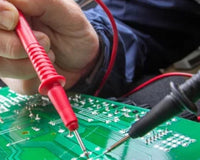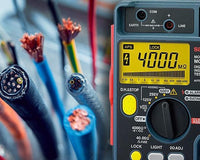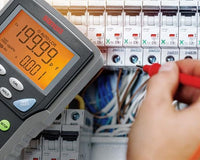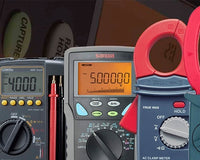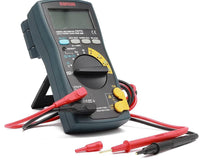What’s a Digital Multimeter?

A digital multimeter is an electrical measuring instrument that measures: DC voltage, AC voltage, DC current, AC current and resistance. Various models provide additional features such as diode, battery and continuity test functions.
Advantages of Digital vs. Analog Multimeters
- Highly accurate measurement. Higher accuracy (1% or less) compared with an analog multimeter (approximately 3%).
- Reduced measuring loss due to high internal impedance (low voltage drop between terminals).
- No parallax reading error occurs as with an analog multimeter.
Which CAT (Category) Safety Rating?
According to the IEC (International Electrotechnical Commission), multimeter manufacturers must follow the safety testing guidelines for all of their products to ensure that each device meets or exceeds the rating required. These measures are put in place to protect the user from unintentional shock, potentially resulting in serious injury or death.
There are four levels defined by the type of load to be measured:
Category Ⅳ (CAT. Ⅳ):
- Equipment used for measurement in low voltage facilities
- Temporary overcurrent preventer, and electric measurement on ripple control unit, etc.
Category Ⅲ (CAT. Ⅲ):
- Equipment used for measurement in building facilities
- Distribution board, circuit breaker, wiring including cables, busbar, junction box, switch, receptacle, and industrial equipment located in fixed facilities, and other equipment such as a fixed motor connected to fixed facilities in a permanent manner.
Category Ⅱ (CAT. Ⅱ):
- Equipment used for measurement performed on a circuit directly connected to low voltage facilities
- Measurement on electric household appliances, portable tools and similar tools
What are the necessary measuring functions?
Choose the necessary functions, except voltage and resistance measurement. (including need for the measurement of current (400mA, 10A, 12A, 20A), capacitor, frequency, temperature and measurement of 4-20mA, etc.)
Other necessary functions?
1) To record measured values concurrently with the process of measurement
→ To fix data by the data hold function.
→ To secure the test lead in the holster.
2) To check changes in measured values
→ Measurement of maximum values, minimum values, and relative values.
Do you need True RMS?

For measurements of waveforms of non-sine waves, choose a model supporting measurements by RMS (Root Mean Square) values. In measuring distorted sine and non-sine waves (square wave, triangular wave, pulse), significant errors occur in measurement by models making measurements by mean values.
There are two types of RMS values:
- AC-Coupled true RMS value: Adapted to measurements of distorted sine and non-sine waves of the AC
- AC + DC-coupled true RMS value : Adapted to measure- ments of waveform containing a DC component.
Learn more about True RMS here...
Additional functionality
Other functions include data transfer to a PC in real time, and a function to record measured data in a built-in memory. To transfer data to a PC, optional connecting cables and PC Link data retrieval software are required in addition to a DMM of PC series.


